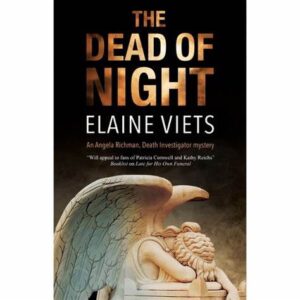 By Elaine Viets
By Elaine Viets
TKZ has had many discussions about whether you should start your novel with a prologue. Readers and editors both have mixed feelings about prologues. My editor prefers first chapters, so that’s how I write my mysteries.
For my new novel, The Dead of Night, the first chapter could have been prologue. It was about the Legend of the Cursed Crypt. The entire book is built on this story.
Please note: I am NOT saying all prologues are bad, just that I made this prologue work as my first chapter.

To start, here’s how the legend would have been as my novel’s prologue:
The Dead of Night Prologue
The Cursed Crypt was a story of love gone wrong. What started as ordinary adultery unleashed two hundred years of plague, fire, floods and, finally, murder at Chouteau Forest University. The school was founded in 1820. The first president, Hiram Thaddeus Davis, was a grim, grave man with a grizzled beard and unforgiving eyes. He promised a well-rounded education in Latin, Greek, history, the Classics, mathematics and “moral philosophy.” Nobody knew what that was, but it didn’t seem to matter. The school was immediately successful. By 1822, the fledgling university was housed in a fine red-brick building and needed another professor.
Davis hired a brilliant scholar with a European pedigree, Eugene Franco Cortini, to teach Latin, Greek and biology. Cortini was devastatingly handsome, with thick black hair and sculpted features. He spoke five languages. He discovered two new species of American wild flowers – and named both after himself.
Cortini championed the theory of evolution long before Darwin. He wrote that Native Americans were really the lost tribes of Israel. And he preached that monogamy was “not a natural or healthy state for the animal kingdom.”
Cortini demonstrated his theory by having a passionate affair with Dolly, President Davis’s eighteen-year-old wife. Poor, balding Davis caught his curvy blonde wife in flagrante with Cortini, running her fingers through the professor’s thick black curls. Never mind where his hands were.
Cortini was fired on the spot, and banished from the campus. Before he left, he cursed the school on a dark windy night. Cortini stood in a circle of stones in front of the school, his hair wild and his black coat flaring, and shouted over the wind, “My Italian grandmother was a strega – a witch – and I inherited her powers. I am a streghone, a warlock. As long as I am banished from this school, death and disaster will fall upon it. As long as I am on the school grounds, it shall be safe.”
President Hiram Davis laughed while the pregnant Dolly Davis, imprisoned in her room, wept bitter tears. After cursing the school, the romantically handsome Cortini left for St. Louis, some forty miles east.
Two days after Cortini left, yellow fever struck the campus, carrying off six of its twenty students. Each month, another disaster hit the campus: lightning destroyed the huge oak in front of the school building. Disease killed the school’s milk cows. Chouteau Forest Creek flooded the fields where the school grew its crops.
Each time, President Davis dismissed these occurrences as unfortunate events and proudly declared that he “refused to give in to superstition.” He was a man of reason – until a fire broke out in the stables and killed his favorite black stallion.
That’s when President Davis invited Eugene Cortini to return to the campus. Cortini could no longer teach, but he was given a brick house to live in and conduct his research. The school flourished for seven years, and expanded to two buildings and a new dormitory.
Then Cortini died suddenly at age thirty-seven in 1845.
President Hiram Davis was taking no chances. He decreed that Cortini must be buried on campus, but he didn’t want the man’s grave on display. Cortini was buried in a crypt under the steps of the Main Building. His final resting place was hidden by a heavy iron door, but Cortini wasn’t forgotten. Students and staff whispered about the late Eugene Cortini, and noticed that Hiram Davis’s oldest son had thick black hair. Both his parents were blond.
Shortly after Cortini was in his crypt, President Davis died. But his school lived on, and so did the legend of Mean Gene Cortini. Every seven years, a disaster struck the school. The school tried to placate Cortini’s restless spirit by lining his crypt with marble. In 1857, a Victorian administration added a marble divan with a tasseled marble pillow, guarded by two weeping angels. A marble slab on the wall proclaimed the tomb was “Sacred to the memory of Eugene Franco Cortini, scholar, teacher, and researcher.”
These improvements didn’t work. The seven-year disaster cycle continued. While the school prospered, the legend lingered like a cloud over the campus.

When I turned the prologue into Chapter 1, the legend became an efficient part of the mystery. It introduced my character, death investigator Angela Richman, and told readers about where she lived and worked, Chouteau County, Mo., home of the one-percent. The last few paragraphs showed readers how the fat cats made money off two hundred years of tragedy. Thanks to this first chapter, the novel was ready to unfold in Chapter 2.
The parts I added to the prologue to make it into Chapter 1 are boldface. The first bold paragraphs introduce the young Angela Richman and show you her place in local society. She’s an outsider, and will stay that way.
At the end of the chapter, the bold paragraphs bring the legend back to the present day and tease what’s going to happen.
See what you think.

The Dead of Night Chapter 1
Like everyone who grew up in Chouteau Forest, Missouri, I knew the legend of the Cursed Crypt. The crypt was at Chouteau Forest University, one of the oldest academies in Missouri. The stories claimed that the restless spirit of a professor nicknamed Mean Gene Cortini had been causing death and destruction in the Forest for two centuries.
I’m Angela Richman, and I learned the legend of Mean Gene and the Cursed Crypt the same way many local teens did: around a campfire in the woods that gave the town of Chouteau Forest its name. When I first heard the tale, I was a gawky fifteen-year-old, the daughter of servants who worked on the Du Pres estate. I didn’t get many invitations to mingle with the cool kids, so when I was asked to join them, I sneaked out of the house one Saturday night to drink beer in a secluded part of the Forest.
It was a chilly March night, and the bare tree branches scraped together like old bones. I hated the bitter taste of the beer, but I wanted to adore my crush, high-school linebacker Danny Jacobs. The firelight turned Danny’s blond hair molten gold and highlighted his six-pack – the one under his tight T-shirt.
Alas, the only sparks that flew that night were from the crackling fire. Danny was devoted to the glamorous head cheerleader. He told us an ancient tale of adultery and betrayal, and we shivered in fear. All except the cheerleader, who was snuggled in Danny’s strong arms.
Here’s the tale, distilled from a thousand nights around local campfires:
The Cursed Crypt was a story of love gone wrong. What started as ordinary adultery unleashed two hundred years of plague, fire, floods and, finally, murder at Chouteau Forest University. The school was founded in 1820. The first president, Hiram Thaddeus Davis, was a grim, grave man with a grizzled beard and unforgiving eyes. He promised a well-rounded education in Latin, Greek, history, the Classics, mathematics and “moral philosophy.” Nobody knew what that was, but it didn’t seem to matter. The school was immediately successful. By 1822, the fledgling university was housed in a fine red-brick building and needed another professor.
Davis hired a brilliant scholar with a European pedigree, Eugene Franco Cortini, to teach Latin, Greek and biology. Cortini was devastatingly handsome, with thick black hair and sculpted features. He spoke five languages. He discovered two new species of American wild flowers – and named both after himself.
Cortini championed the theory of evolution long before Darwin. He wrote that Native Americans were really the lost tribes of Israel. And he preached that monogamy was “not a natural or healthy state for the animal kingdom.”
Cortini demonstrated his theory by having a passionate affair with Dolly, President Davis’s eighteen-year-old wife. Poor, balding Davis caught his curvy blonde wife in flagrante with Cortini, running her fingers through the professor’s thick black curls. Never mind where his hands were.
Cortini was fired on the spot, and banished from the campus. Before he left, he cursed the school on a dark windy night. Cortini stood in a circle of stones in front of the school, his hair wild and his black coat flaring, and shouted over the wind, “My Italian grandmother was a strega – a witch – and I inherited her powers. I am a streghone, a warlock. As long as I am banished from this school, death and disaster will fall upon it. As long as I am on the school grounds, it shall be safe.”
President Hiram Davis laughed while the pregnant Dolly Davis, imprisoned in her room, wept bitter tears. After cursing the school, the romantically handsome Cortini left for St. Louis, some forty miles east.
Two days after Cortini left, yellow fever struck the campus, carrying off six of its twenty students. Each month, another disaster hit the campus: lightning destroyed the huge oak in front of the school building. Disease killed the school’s milk cows. Chouteau Forest Creek flooded the fields where the school grew its crops.
Each time, President Davis dismissed these occurrences as unfortunate events and proudly declared that he “refused to give in to superstition.” He was a man of reason – until a fire broke out in the stables and killed his favorite black stallion.
That’s when President Davis invited Eugene Cortini to return to the campus. Cortini could no longer teach, but he was given a brick house to live in and conduct his research. The school flourished for seven years, and expanded to two buildings and a new dormitory.
Then Cortini died suddenly at age thirty-seven in 1845.
President Hiram Davis was taking no chances. He decreed that Cortini must be buried on campus, but he didn’t want the man’s grave on display. Cortini was buried in a crypt under the steps of the Main Building. His final resting place was hidden by a heavy iron door, but Cortini wasn’t forgotten. Students and staff whispered about the late Eugene Cortini, and noticed that Hiram Davis’s oldest son had thick black hair. Both his parents were blond.
Shortly after Cortini was in his crypt, President Davis died. But his school lived on, and so did the legend of Mean Gene Cortini. Every seven years, a disaster struck the school. The school tried to placate Cortini’s restless spirit by lining his crypt with marble. In 1857, a Victorian administration added a marble divan with a tasseled marble pillow, guarded by two weeping angels. A marble slab on the wall proclaimed the tomb was “Sacred to the memory of Eugene Franco Cortini, scholar, teacher, and researcher.”
These improvements didn’t work. The seven-year disaster cycle continued. While the school prospered, the legend lingered like a cloud over the campus.
More than a hundred years later, Chouteau Forest’s crafty one percent figured out how to make money out of the ancient tragedy. In the 1980s, the University Benefactors’ Club started auctioning off “A Night in Mean Gene’s Cursed Crypt.”
The money went to benefit Chouteau Forest University, which soon had a fat endowment.
The prize was a big one: if any auction winner could stay the full night in the Cursed Crypt, they would be granted membership in the elite Chouteau Founders Club, which ran the Forest. The winners’ future in the Forest would be guaranteed.
So far, only one person had stayed the night in the gloomy crypt.
I was forty-one now, long past drinking beer while listening to ghost stories. I worked for the Chouteau County Medical Examiner’s office as a death investigator. That meant I was in charge of the body at the scene of a murder, an accident or an unexplained death. It had been more than a quarter of a century since I’d first heard the legend of Cursed Crypt in the night-struck woods, and I didn’t believe a word of it.
Until I saw the bodies.
© Elaine Viets and Severn House

The Dead of Night is hot off the presses as an ebook and a hardcover. Here are three ways to buy it:
(1) AMAZON. https://tinyurl.com/4846s7jr
(2) BARNES & NOBLE. http://tiny.cc/a876vz
(3) BOOKSHOP.ORG. Save $2 on The Dead of Night at Bookshop.org and support independent bookstores: https://tinyurl.com/2p8p9ze4
I’d love for you to buy my books, but please check the e-book and hardcover prices at each bookseller. Prices for both change.

Good morning, all. I’m getting my car towed and I’ll stop by when I can.
Oh no!
What a graceful way to embed a prologue into Chapter 1, Elaine. Esp. helpful for series writers where introducing the main character in a fresh way gets difficult after several books.
Best of luck with your car. 🙁
Thans, Debbie. Compared to the biblical floods we’re having in this area, a stranded car is an inconvenience. #firstworldproblem.
What??!! You can’t just stop by and say, “I’m getting my car towed…” Are you all right? And wow! You changed an ordinary prologue into something I have to read.
I’m back. My car battery died and I had to leave my car in a RaceTrak lot. We’ve had a tropical storm here and the roads near the beach were closed. Finally got out today and got a ride to the RaceTrak. It was in a flood zone, and there was a rescue boat in the parking lot. I am not kidding. The tow truck couldn’t get through. I am safely home and will try to get my car towed tomorrow.
Sure, she can. KillZone is a lot more than a blog IMNSHO; it’s a community.
Thanks. It is — a refuge as well as a learning place.
About 2/3 through Dead of Night. Enjoying every page. No word from my eldest child, but finals are next week. Their copy did arrive.
glad you are enjoying it so far, Alan. Good luck to L. for her finals.
For me, prologues work best when there’s an immediate, obvious tie between it and the first chapter. My favorite is in Renegades by Marissa Meyer. The prologue shows the protag at six witnessing her family getting murdered, and chapter 1 opens with her intent to kill those who were supposed to protect them. Obvious tie, and wouldn’t have worked any other way.
Excellent example, Azali, and in my opinion, about the only time when prologues work well.
I hope you can get your car towed tomorrow. Elaine.
Great way to sandwich the prologue into Chapter One and grab interest quickly. I’m going to think of that technique any time I’m tempted to write a prologue. The Legend of the Cursed Crypt quickly became the “disturbance” and it certainly kept me reading.
Thanks, Elaine!
Glad you stopped by, Steve, and that my example was helpful. Not sure I’m going to get my car tomorrow, either. We’re now expecting hail and possible tornados.
I hope you get your car towed soon, Elaine.
I’m neither for nor against prologues. It seems to me the author needs to do whatever is best for the story. I liked the way you incorporated the background into your Chapter One, and I look forward to reading the rest of the book. (Love the cover!)
Chapter One is great! I could smell the fire, see and hear the sparks flying up in the woods. The beer was bitter, too.
You made me laugh! The chapter suceeded.
I agree, Kay. The first rule of writing is that there are no rules.
Elaine: A subject dear to my heart, and those of all the Boys in my Basement. My criteria for a prologue: (1) Provides vital background info; (2) Isn’t part of the main story line; (3) Involves another time, place, or narrator; (4) Is about a half page; (5) Clarifies or sets the mood or scene for what follows; (6) Reveals theme; or (7) Shows the greater setting (e.g., WWII).
If ever there was a story that calls for a prologue, this is it, going by Items (1)(2)(3)(5) and (6). At 700 words, it’s much too long for (4), and Item (7) isn’t relevant. As an exercise, I pared an awful version to ~350 words, though the most amusing details should probably be retained for dialogue in later chapters. E.g., perhaps the MC could note the problematic hair colors in a photo on a wall.
You just gave a succinct guideline for how to use a prologue. All good points.
I rarely use prologues these days as I have learned that many editors consider them old-fashioned. But as has been pointed out, sometimes they are appropriate.
I’ve known editors to refuse to buy a book unless the author gets rid of the prologue. Sometimes, the easiest step is to just kill the prologue and put the information in later.